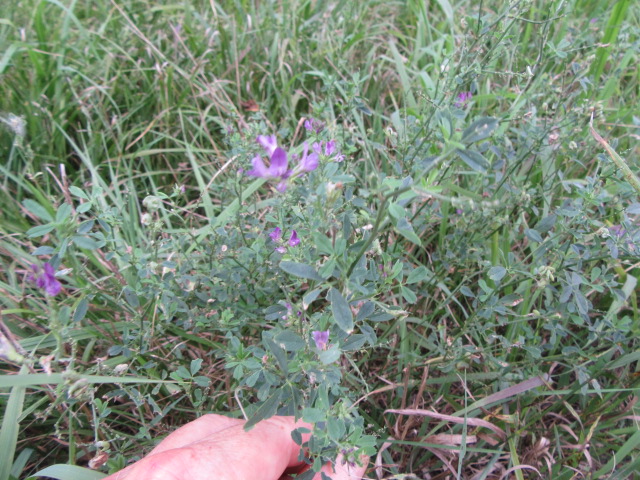
Medicago sativa (Alfalfa) on 8-2-19, #609-28.
Alfalfa
Medicago sativa
(Medicago sativa subsp. sativa)
med-DIK-ah-go sa-TEE-vuh
Synonyms of Medicago sativa (4)(Updated on 12-18-23 from Plants of the World Online): Medica sativa (L.) Mill. (1768), Medicago sativa var. vulgaris Alef. (1866)(not validly publ.), Medicago sativa subsp. vulgaris (Alef.) Arcang. (1882)(not validly publ.), Medicago vera Kirschl. (1870)(nom. superfl.)
Synonyms of Medicago sativa subsp. sativa (52) (Updated on 12-18-23 from Plants of the World Online): Medica legitima Greene (1894), Medica sativa f. alba Benke (1935), Medicago afghanica (Bordz.) Vassilcz. (1946), Medicago angulata Láng ex Neilr. (1865), Medicago asiatica Sinskaya (1950)(nom. superfl.), Medicago asiatica subsp. geratica Sinskaya (1950), Medicago asiatica subsp. khivinica Sinskaya (1950), Medicago asiatica subsp. sinensis Sinskaya (1950), Medicago asiatica subsp. sinensis Sinskaya (1950), Medicago asiatica subsp. turcomanica (Bordakov) Sinskaya (1950), Medicago asiatica subsp. turkestanica (Vilbouchevich) Sinskaya (1950), Medicago contorta Gilib. (1782)(opus utique oppr.)Medicago eusativa Sinskaya (1950)(no Latin descr.), Medicago glutinosa var. panzeriana DC. (1825), Medicago jemenensis Sinskaya (1950)(no Latin descr.), Medicago karatschaica Latsch. (1959), Medicago kopetdaghi Vassilcz. (1946), Medicago mesopotamica Vassilcz. (1946), Medicago orientalis Vassilcz. (1946), Medicago orientalis subsp. anatolica (Bordakov) Sinskaya (1950), Medicago orientalis var. austroeuropaea Bordakov (1929), Medicago orientalis var. erecta Schweinf. (1896), Medicago orientalis subsp. graeca Sinskaya (1950), Medicago polia (Brandegee) Vassilcz. (1946), Medicago praesativa Sinskaya (1950)(no Latin descr.), Medicago sativa grex afghanica Bordz. (1929), Medicago sativa f. alba Benke (1935), Medicago sativa var. anatolica Bordakov (1929), Medicago sativa grex euasiatica Sinskaya (1940), Medicago sativa var. integrifoliola C.W.Chang (1981), Medicago sativa subsp. kandagharokabulica (Bordakov) Sinskaya (1950), Medicago sativa subvar. kandagharokabulica Bordakov (1929), Medicago sativa subsp. macrocarpa Urb. (1873), Medicago sativa subsp. microcarpa Urb. (1873), Medicago sativa var. polia Brandegee (1907), Medicago sativa grex praecocissima Sinskaya (1940), Medicago sativa f. prolifera Dore (1959), Medicago sativa subvar. provincialis Bordakov (1929), Medicago sativa f. salaverryensis J.F.Macbr. (1930), Medicago sativa var. syriacopalestinica Bordakov (1929), Medicago sativa var. tripolitanica Bordakov (1929), Medicago sativa var. turcomanica Bordakov (1929), Medicago sativa var. turkestanica Vilbouchevich (1895), Medicago sativa subvar. vavilovii Bordakov (1929), Medicago sogdiana Vassilcz. (1946), Medicago sogdiana var. chivensis Vassilcz. (1949), Medicago syriacopalestinica (Bordakov) Sinskaya (1950), Medicago tadzhicorum Vassilcz. (1981), Medicago transoxana Vassilcz. (1946), Medicago transoxana var. kopetdaghi (Vassilcz.) Khass. (1972), Medicago tripolitanica (Bordakov) Sinskaya (1950), Trigonella upendrae H.J.Chowdhery & R.R.Rao (1989 publ. 1992). There were 25 on the last update on 2-14-22…
Medicago sativa L. is the accepted scientific name for Alfalfa. The genus and species were named and described as such by Carl von Linnaeus in the second volume of the first edition of Species Plantarum in 1753.
Accepted Infraspecific Names (3) (Updated on 2-14-22 from POWO): Medicago sativa nothosubsp. faurei Maire (1932), Medicago sativa subsp. glomerata (Balb.) Rouy (1899), *Medicago sativa subsp. sativa (autonym). *When an infraspecific taxon is named, an autonym (“type-specimen”) is automatically generated whose description is closest to the (original) species. All have their own list of synonyms…
As of 12-18-23 when this page was last updated, Plants of the World Online lists 90 species in the Medicago genus. It is a member of the plant family Fabaceae with 793 genera. Those numbers could change as updates are made on POWO.
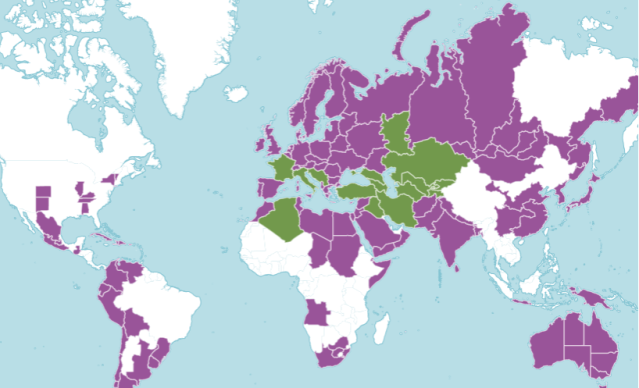
Distribution map of Medicago sativa from Plants of the World Online. Facilitated by the Royal Botanic Gardens, Kew. Published on the Internet; http://www.plantsoftheworldonline.org/. Retrieved on April 13, 2021.
The above distribution map for Medicago sativa is from Plants of the World Online. Areas in green are where the species is native and purple is where it has been introduced. POWO gets some of their maps for the United States and Canada from Flora of North America for families recognized on that site. When I wrote this page FNA had not yet included genera from the plant family Fabaceae. FNA is working on this family and will be released soon then POWO will update their maps.
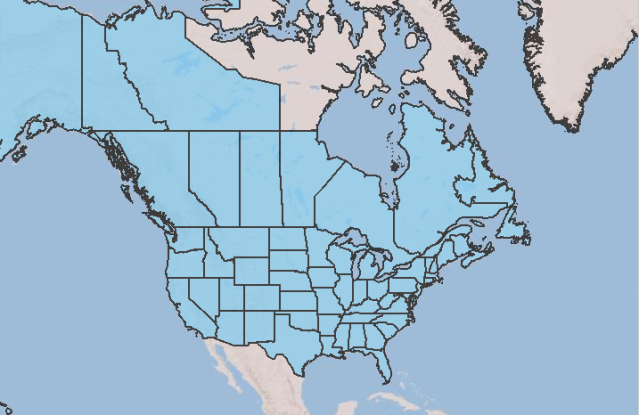
Distribution map for Medicago sativa from the USDA Plants Database. Published on the internet at https://plants.sc.egov.usda.gov/home. Retrieved on May 16, 2021.
The map on the USDA Plants Database for North America is quite different… All areas in blue are where the species has been introduced. Well, Alfalfa is a popular legume for hay which is how it has been introduced to most of the world.
The map on iNaturalist shows where members have made observations. Anyone can join and it is a great website to confirm and share your observations. The maps on iNaturalist are continually updated as members post new observations.
THERE ARE SEVERAL LINKS AT THE BOTTOM OF THE PAGE FOR FURTHER READING AND TO HELP WITH A BETTER POSITIVE ID.
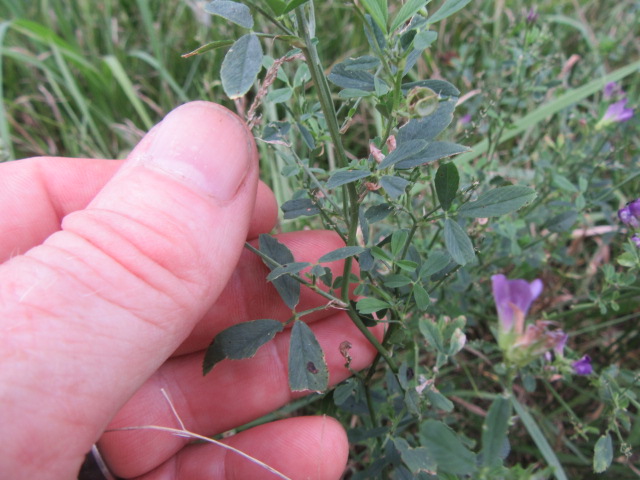
Medicago sativa (Alfalfa) on 8-2-19, #609-29.
You know, as widespread as this species is I have only seen it one time growing in the wild. Actually, I saw it growing along the road while walking back from park next to the farm. One solitary plant that obviously had been mowed off many times. I didn’t even realize it was Alfalfa until I uploaded photos on iNaturalist…
Information online says Medicago sativa (Alfalfa) is a native of Eurasia but it possibly originally came from south-central Asia (which is part of Eurasia). However, it is believed to have been first cultivated in Iran since Pliny and Palladius called it medica (Latin), referring to the Medes who were from Iran. It is the most widely grown legume in the world for hay, silage, grazing, green manure, and cover crops. Although we call it Alfalfa in North America, in other countries it is commonly called Lucerne.
Medicago sativa is a long-lived species. According to the Wikipedia article, it “normally lives 4-8 years but can live for more than 20, depending on the variety and climate.” It further states the taproots can grow to a depth of more than 49 feet but typically grow 7-10 feet deep.
Medicago sativa is easily recognized since it is the only Medicago species in Missouri with purple flowers, it has fairly large stipules at the base of the petioles (leaf stems), it differs from other purple-flowered legumes by its trifoliate leaves and its tightly coiled seedpods.
Although Alfalfa can be seen randomly along backroads, streams, trails, etc. as an escapee, it apparently poses no threat to natural habitats like some introduced species do.
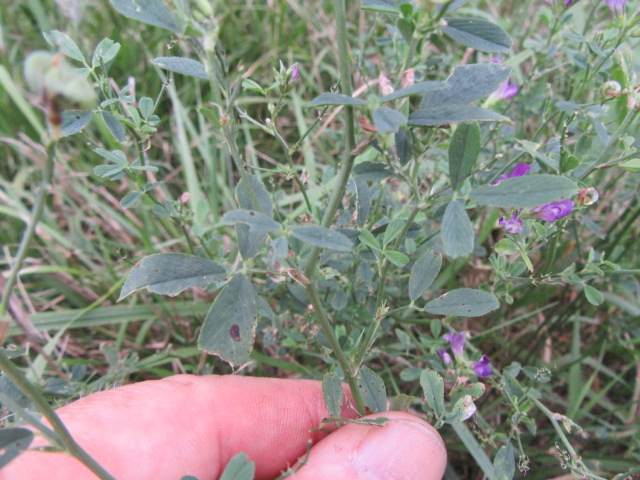
Medicago sativa (Alfalfa) on 8-2-19, #609-30.
The stems can be ascending or erect, growing from 1- 2 1/2 ‘ or more. Alfalfa grows a tough crown that contains shoots that allow it to regrow after being cut multiple times.
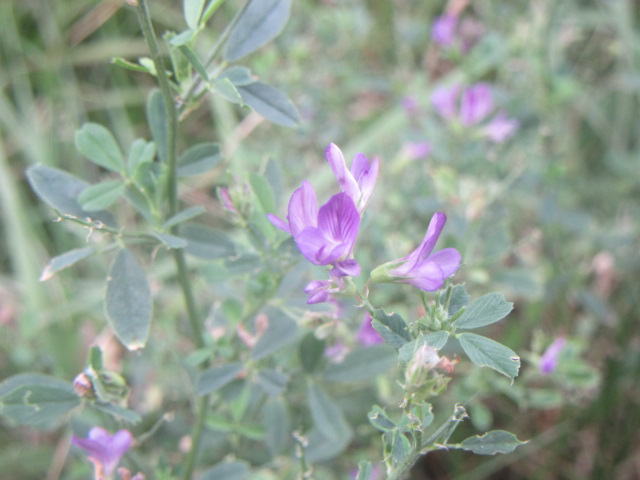
Medicago sativa (Alfalfa) on 8-2-19, #609-31.
The leaves resemble clover in young plants but elongate as plants mature. The leaves grow in an alternate manner along the stems, are trifoliate with 3 leaflets, have petioles (leaf stems), and stipules at the base of the petioles. The leaflets are said to be oblanceolate, elliptic, oblanceolate in shape, with a few teeth along the margins. The surfaces are smooth (glabrous) or sparsely hairy (pubescent).
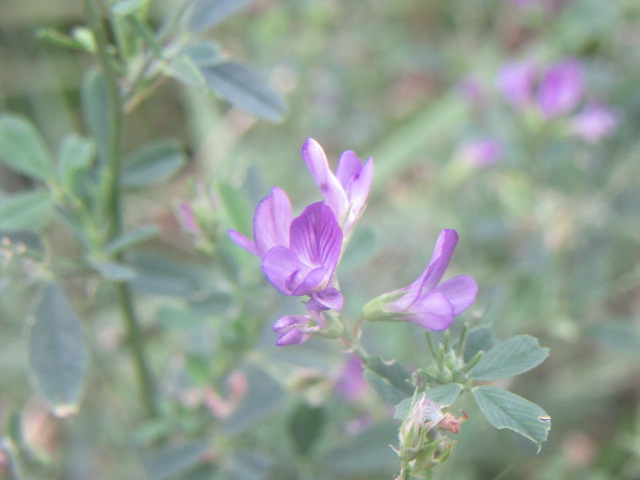
Medicago sativa (Alfalfa) on 8-2-19, #609-32.
The stems terminate in compact, headlike clusters of 10-30 flowers. The flowers are fairly typical of other members of the plant family Fabaceae and are said to be papilionaceous (pea-like)… Meaning they have standard, wing, and keel petals. In this case, the standard and keel petals are spread apart revealing the throat of the flowers and the 10 stamens are about equal in length. Of course, the flowers are purplish in color…
The seed pods are curved, loosely to tightly coiled in 2-3 turns, flat-sided, have a reticulated surface, and contain 10-20 yellowish-brown seeds.
<<<<2021>>>>
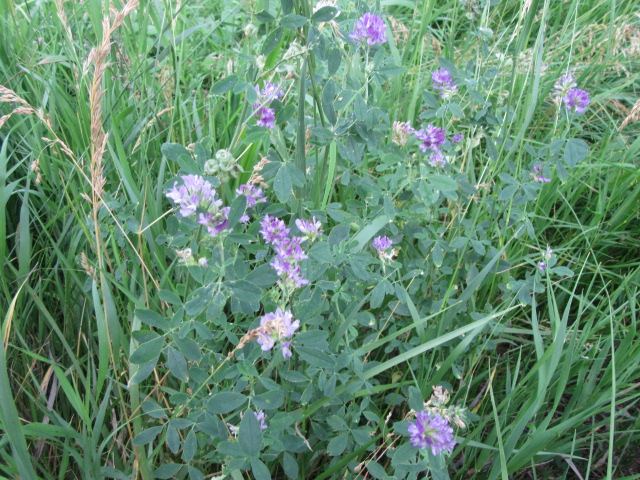
Medicago sativa (Alfalfa) on 6-16-21, #801-55.
I took a few more photos of the resident Medicago sativa on June 16 in 2021 in the same location.
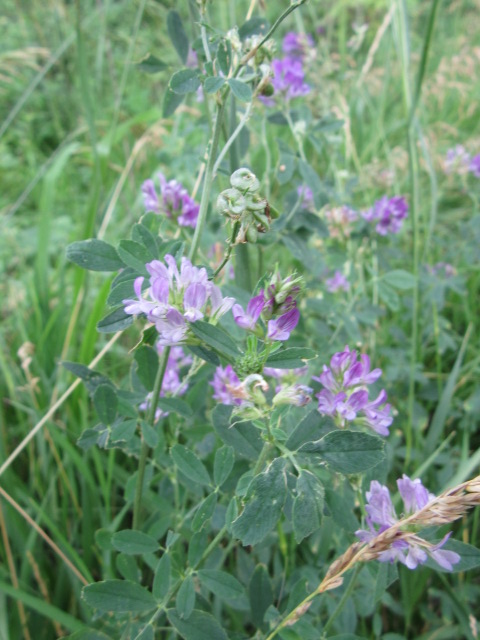
Medicago sativa (Alfalfa) on 6-16-21, #801-56.
It was a fairly windy day, so getting close-ups was out of the question…
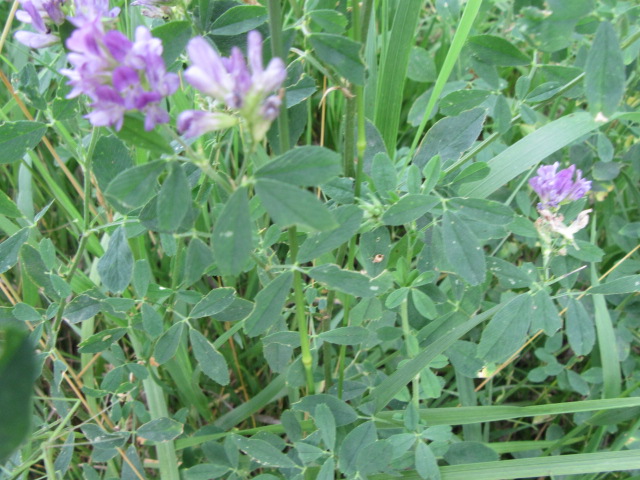
Medicago sativa (Alfalfa) on 6-16-21, #801-57.
I have enjoyed photographing and learning about the many wildflowers growing on the farm and in other areas. I have grown over 500 different plants and identified over 250 species of wildflowers (most have pages listed on the right side of this site). I am not an expert, botanist, or horticulturalist. I just like growing, photographing, and writing about my experience. I rely on several websites for ID and a horticulturalist I contact if I cannot figure them out. Wildflowers can be somewhat variable from location to location, so sometimes it gets a bit confusing. If you see I have made an error, please let me know so I can correct what I have written.
I hope you found this page useful and be sure to check the links below for more information. They were written by experts and provide much more information. Some sites may not be up-to-date but they are always a work in progress. If you can, I would appreciate it if you would click on the “Like” below and leave a comment. It helps us bloggers stay motivated. You can also send an email to me at thebelmontrooster@yahoo.com. I would enjoy hearing from you especially if you notice something is a bit whacky.
FOR FURTHER READING:
PLANTS OF THE WORLD ONLINE (GENUS/SPECIES)
INTERNATIONAL PLANT NAMES INDEX (GENUS/SPECIES)
TROPICOS (GENUS/SPECIES)
FLORA OF MISSOURI (GENUS/SPECIES)
WORLD FLORA ONLINE (GENUS/SPECIES)
WIKIPEDIA (GENUS/SPECIES)
USDA PLANTS DATABASE
USDA FACT SHEET
MISSOURI PLANTS
DAVE’S GARDEN
FRIENDS OF THE WILDFLOWER GARDEN
iNATURALIST
WILDFLOWER SEARCH
ILLINOIS WILDFLOWERS
MINNESOTA WILDFLOWERS
PFAF (PLANTS FOR A FUTURE)
GO BOTANY
FLORA FINDER
SOUTHWEST DESERT FLORA
SOUTHWEST COLORADO WILDFLOWERS
EDIBLE WILD FOOD
NOTE: The data (figures, maps, accepted names, etc.) may not match on these websites. It depends on when and how they make updates and when their sources make updates. Some websites have hundreds and even many thousands of species to keep up with. Accepted scientific names change periodically and it can be hard to keep with as well. Some of the links may use a name that is a synonym on other sites. In my opinion, Plants of the World Online by Kew is one of the most reliable and up-to-date plant databases and they make updates regularly. I make updates “at least” once a year and when I write new pages or add new photos but I do get behind. We are all a work in progress. 🙂